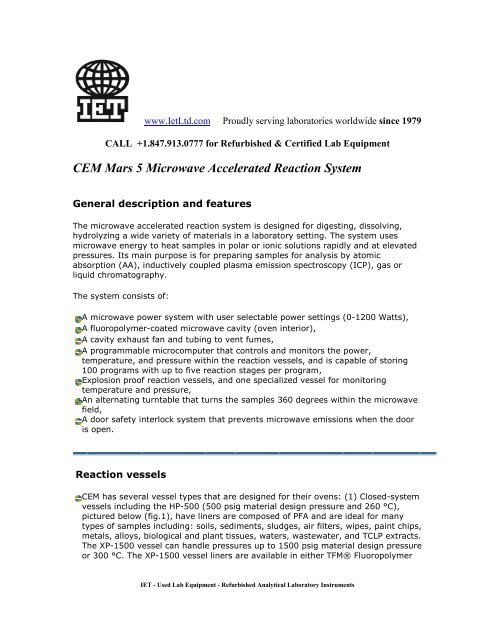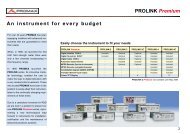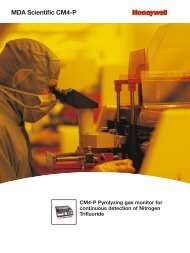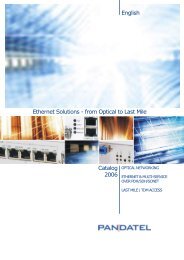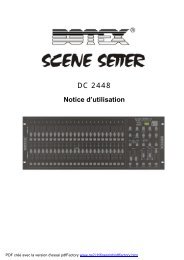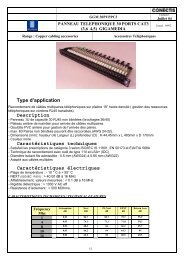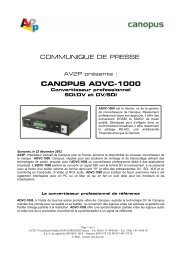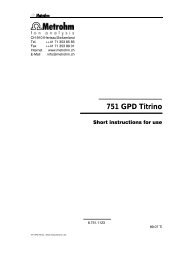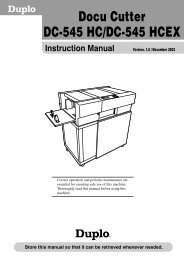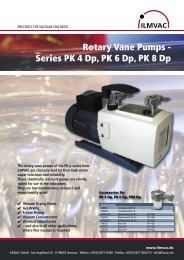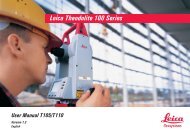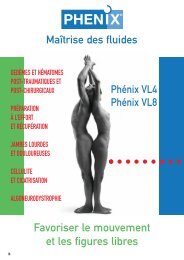Mars 5 - Conquer Scientific
Mars 5 - Conquer Scientific
Mars 5 - Conquer Scientific
You also want an ePaper? Increase the reach of your titles
YUMPU automatically turns print PDFs into web optimized ePapers that Google loves.
www.IetLtd.com Proudly serving laboratories worldwide since 1979CALL +1.847.913.0777 for Refurbished & Certified Lab EquipmentCEM <strong>Mars</strong> 5 Microwave Accelerated Reaction SystemGeneral description and featuresThe microwave accelerated reaction system is designed for digesting, dissolving,hydrolyzing a wide variety of materials in a laboratory setting. The system usesmicrowave energy to heat samples in polar or ionic solutions rapidly and at elevatedpressures. Its main purpose is for preparing samples for analysis by atomicabsorption (AA), inductively coupled plasma emission spectroscopy (ICP), gas orliquid chromatography.The system consists of:A microwave power system with user selectable power settings (0-1200 Watts),A fluoropolymer-coated microwave cavity (oven interior),A cavity exhaust fan and tubing to vent fumes,A programmable microcomputer that controls and monitors the power,temperature, and pressure within the reaction vessels, and is capable of storing100 programs with up to five reaction stages per program,Explosion proof reaction vessels, and one specialized vessel for monitoringtemperature and pressure,An alternating turntable that turns the samples 360 degrees within the microwavefield,A door safety interlock system that prevents microwave emissions when the dooris open.Reaction vesselsCEM has several vessel types that are designed for their ovens: (1) Closed-systemvessels including the HP-500 (500 psig material design pressure and 260 °C),pictured below (fig.1), have liners are composed of PFA and are ideal for manytypes of samples including: soils, sediments, sludges, air filters, wipes, paint chips,metals, alloys, biological and plant tissues, waters, wastewater, and TCLP extracts.The XP-1500 vessel can handle pressures up to 1500 psig material design pressureor 300 °C. The XP-1500 vessel liners are available in either TFM® FluoropolymerIET - Used Lab Equipment - Refurbished Analytical Laboratory Instruments
or quartz, and are useful in digests of oils and heavy organics, hazardous wastes,refractory materials & ceramics, and ores and slags. CEM also makes a highthroughput accessory set for digesting over 50 samples in an open-vessel (50 ml.polypropylene centrifuge tubes). Digestion with this system is temperaturecontrolled and samples should be readily decomposable. Since venting is notcontrolled this type of system is not recommended for analyzing trace volatilecompounds.A number of safeguards have been incorporated in the MARS 5 system toeliminate the possibility of an explosive high pressure material failure. Eachreaction vessel fits within a microwave-transparent sleeve made of Kevlar, andeach vessel-sleeve assembly gets clamped within a carriage or 'support module'with 5 foot-pounds of torque applied to the clamping bolt. A plastic membranepressure rupture disc that fits between the exhaust port in the vessel lid and thethreaded blue cap (shown in figure 1, and 2) ensures the digestion takes placeunder completely closed conditions at lower pressures. The blue cap has a smallhole drilled in it. Should pressures exceed what is safe for the particular vessel themembrane will rupture, exhausting gas through the port in the vessel lid and thecap and into the oven, which exhausts into a fume hood. The microwave oven alsohas a rupture pressure sensor that stops the power to the microwave if it detects asudden pressure change.Figure 1. From left to right; control vessel in the support module withpressure sensor attached and fiber optic temperature sensor inserted, atypical reaction vessel in a support module, and an assembled reactionvessel showing the explosion-proof Kevlar sleeve and the load distributingcap piece placed on the vessel lid.The plastic membrane rupture disc can easily be placed inside the blue cap withthe pen-sized suction cup devise supplied by the manufacturer. See figure 2.IET - Used Lab Equipment - Refurbished Analytical Laboratory Instruments
Figure 2. From left to right; threaded blue cap that fits on the reactionvessel lid and into which a pressure membrane (in the black box) isplaced with the pen-sized suction devise.Control VesselOnly one reaction vessel of a set of 14 vessels (per carousel) is monitored fortemperature and pressure. The amount of power supplied by the oven and the rateof temperature and pressure increase within the vessels is regulated by theparameters of a user-defined computer program. The power is modulated based onthe temperature and pressure measured within a specialized control vessel (figures1, 3, and 4). Since the amount of heating within a solution is dependant on the typesof ions and dipolar molecules present it is important that the sample placed in thecontrol vessel be representative of the other samples digested simultaneously.The control vessel is made of the same material as the other reaction vessels exceptthat it also has a pressure sealed glass well (Thermowell) that penetrates into thevessel to allow a fiber optic temperature sensor to be lowered into the vessel. Apressure sensor is also attached to the control vessel lid. See figure 3.Thermowell and fiber optic temperature sensorThe Thermowell is a glass tube open at only one end. The open end fits into acompression fitting in a threaded cap that tightens as it screws on to the controlvessel lid and allows the temperature sensor to be lowered into the pressure sealedvessel. The closed end of the Thermowell is submerged in the sample mixture.IET - Used Lab Equipment - Refurbished Analytical Laboratory Instruments
Temperature in the sample mixture as it is heated is measured by a microwavetransparentinfrared fiber optic sensor. One end of the sensor is lowered into theThermowell and the other is connected to a snap-in port in the oven (see figure 8).The temperature sensor that can read up to 300 °C and is completely inert to allcorrosive reagents.Pressure sensorThe pressure control system can read pressures up to 1500 psig and is composed oftwo parts: (1) the control electronics and connector, which are built into the oven,and (2) the sensor which is connected to the control vessel lid via a flexiblemicrowave transparent tube (the blue tubing shown below is a sheath that surroundsthe pressure line). The sensor consists of a pressure sensing load-cell mechanismlocated within the black cylinder attached to the tubing, and gets mounted to theconnector in the oven cavity. See figure 3, 4 and 8. During operation the pressureswithin the reaction vessels are transmitted to the load cell which sends a signal tothe electronic control unit. Unlike older microwave systems that had pressure linescharged with water, the MARS5 system relies on control vessel vapor pressuredirectly acting on the load cell. Both the pressure sensor and temperature sensorscan be calibrated and zeroed using the microwave oven's computer.Figure 3. Control vessel parts, from left to right: Vessel lid with pressurerelease check valve and pressure transducer attached, glass thermal wellwith compression fitting and fiber optic temperature sensor, Teflonreaction vessel, Kevlar explosion proof sleeve, and pressure transducer.IET - Used Lab Equipment - Refurbished Analytical Laboratory Instruments
Figure 4. Control vessel assembled and housed in the support module.The CarouselTo promote even heating among and within all the reaction vessels in themicrowave oven cavity they are rotated through the microwave field using acarousel. The carousel is essentially a turntable that holds up to 14 supportmodules and reaction vessels. (The MARS 5 HP-500 system has 14 vessels percarousel, different systems will hold more or fewer support modules). Theturntable rides on ball rollers and is turned 360 degrees per cycle, alternating thedirection of rotation in each cycle. The turntable fits on a drive lug within the oven.See figures 5 and 6.In addition to rotating the vessels in the microwave field the oven also has thecapacity to rotate small magnetic stirring bars that can be placed within thereaction vessels to ensure even mixing. This feature can be useful in an extractionprotocol.The support modules are secured to the turntable with an interlocking key system,and an outer plastic ring is placed around the top of the support modules foradditional support and for explosion containment.IET - Used Lab Equipment - Refurbished Analytical Laboratory Instruments
Figure 5. Carousel, showing pressure sensor and fiber optic temperaturesensor attached to the control vessel and outer plastic ring around all ofthe support modules.Figure 6. Carousel bottom; showing the ring of ball rollers and receptaclefor the drive lug.The OvenExternal features:IET - Used Lab Equipment - Refurbished Analytical Laboratory Instruments
Push button door opener on the top operates the safety door latch.On/off switch is located on the side above the air intake.Microcomputer keyboard and display are on the front.Exhaust tubing and blower are attached from the back. These remove harmfulfumes from the cavity to a fume hood or approved air handling device.Power cord receptacle and access to fuses are on the back.The oven also features the Reactiguard system, which senses pressure changeswithin the oven cavity in the event of a sudden pressure change and then shutsdown the power.User programmable microcomputerThe oven's microcomputer has a menu of preprogrammed settings. Some of theseare EPA methods, and some are methods developed by CEM Corp. The user canalso change a number of the ovens parameters including the percentage of powerapplied, the total wattage, control temperature, pressure, ramp and hold time, andthe number of reaction stages or cycles.The measured values for time, power, pressure, and temperature can be storedand recovered within the computer or sent to a remote computer for analysis onsome oven models.Figure 7. Oven exteriorIET - Used Lab Equipment - Refurbished Analytical Laboratory Instruments
Figure 8. Inside the oven; showing the pressure and temperature sensorconnections. The temperature sensor connection is located in the middleof the oven ceiling. The pressure tubing wraps around the temperatureconnector, and is attached to the oven ceiling with a removable plasticclip.Accessories for the MARS 5 supplied by CEM Corp.Stirring The stirring option provides variable speed stirring in each individualvessel. A magnetic spin bar is placed into the vessel to provide sample stirring.This insures sample homogeneity and eliminates possible temperature gradients.Stirring speed is controllable from the main program software screen. Includes 14stir bars. This option is recommended for all applications.Available Stir BarsDigestionExtraction - Egg ShapedExtraction - Octagon ShapedExtraction - Carboflon Filled (for use with non-polar solvents)A rotating plate containing magnets is located underneath the MARS cavity floor.The magnetic field couples with a spin bar placed into the vessel to affect samplestirring.MARSLink Software (Version 2.0) This powerful, yet easy-to-use, Windows®based,multi-tasking software package connects the MARS 5 System to any PC(configured with Windows® 3.1 or higher). The software provides method storage,data collection, real-time graphic display of temperature and pressure profiles andreport writing capabilities. Includes program disk (3.5" & 5.25" formats), 12 ft.null modem serial cable with RS-232 connectors and installation guide.IET - Used Lab Equipment - Refurbished Analytical Laboratory Instruments
Computer requirements: IBM PC or compatible running Microsoft Windows®Version 3.1 or higher, Windows® 95 or higher, or Windows® NT.MicroVap Accessory Set Enhance the performance of your CEM microwavedigestion system with this accessory for pre- and post digestion processing. TheMicroVap makes drying of samples before digestion as easy and clean as possible!It also reduces acid volume after the digestion step and concentrates acidifieddrinking water samples. Process up to 12 samples at a time using a variety of CEMmicrowave digestion liners. An optional HEPA filter can be used to control thesample environment. Samples are exposed to microwave energy while under avacuum to accelerate the sample drying and acid volume reduction steps. An“auto-detect” feature of the MARS 5 system software determines when the sampleevaporation step is complete and automatically stops operation. Acid fumes areautomatically neutralized by the integrated vapor scrubber module.A typical procedure for preparing plant material for ICP/MSDried plant material (0.1 - 0.5 grams of homogeneous material) is weighed outand placed in each reaction vessel.Concentrated acid (10 ml 70% nitric acid) or dilute acid and oxidizer (5ml H2O + 5ml 70% nitric acid + 2 ml 30% hydrogen peroxide) are added to each vessel. Theprecise recipe can vary depending on the material to be digested and who needsthe information. For the sake of uniformity, specific methods have been developedthat are prescribed by the EPA and ASTM for the digestion of certain material. Seethe links to methods section. It is recommended that the mixture allow to sit for15 minutes before tightening the reaction vessel lids to allow any vigorousoxidation to vent.The vessels are placed in the support modules with the load distributing caps, andtightened with a torque wrench to 5 ft*lbs. Blue pressure caps (with pressuremembranes inserted) are to be hand tight. Attach pressure sensor and Thermowellto the control vessel. Place the support modules on the carousel and attach the topring.Either select pre-programmed microwave control settings from the menu installedon the oven's computer, or program in parameters for power, control temperature,pressure maximum, ramp time, hold time and stage settings that you select or arespecified by a standard procedure. Zeroing the pressure sensor every so often isrecommended.Place the carousel on the drive lug in the oven and attach the pressure sensor andtemperature sensor. Close the door, press start.After the cool down period when the temperature sensor reads below 35 degrees Cit is safe to remove the carousel from the oven. Pressure in the reaction vesselsshould be released slowly by unscrewing the blue cap and venting any remainingvapors in a fume hood.Samples should be filtered through filter paper or centrifuged and diluted to anappropriate final volume (ICP machines need to have acid concentrations be below20%).IET - Used Lab Equipment - Refurbished Analytical Laboratory Instruments
Sample handling and safetyA number of precautions should be observed for safe operation of themicrowave system:Before subjecting vessels to microwave energy the vessels should be free ofparticulate matter or drops of liquid such as high salt solutions that can absorbmicrowaves, which in turn can cause localized heating and damage to the vessel.Pressure relief devices should always be used when heating samples.When working with unknown samples it is suggested that the user allow 15minutes to predigest the samples before sealing the vessel. This will allow foreasily oxidized compounds to exhaust volatile gasses and diminish the pressureinside the vessel during heating.Never heat high boiling point acids like concentrated sulfuric or phosphoric acid inthe microwave.The user should consult the operation manual for the list of solutions and solventsnot recommended for use in the system or in the particular reaction vessel you areusing.Figure 9. After the microwave digestion and the cooldown period the pressure in the reaction vessels should bereleased by slowly unscrewing the blue cap and ventingany remaining vapors in a fume hood.IET - Used Lab Equipment - Refurbished Analytical Laboratory Instruments
Proudly serving laboratories worldwide since 1979CALL +1.847.913.0777 for Refurbished & Certified Lab EquipmentIET - Used Lab Equipment - Refurbished Analytical Laboratory Instruments


